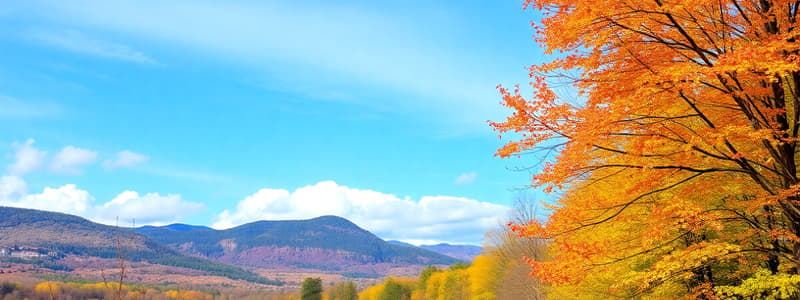Podcast
Questions and Answers
What defines the weather typically experienced in summer?
What defines the weather typically experienced in summer?
- Mild temperatures with falling leaves.
- Shortest days with frequent snow.
- Highest temperatures with sunny and dry conditions. (correct)
- Light rain and cooler temperatures.
Which season is known as the transition period from warm to cooler temperatures?
Which season is known as the transition period from warm to cooler temperatures?
- Summer
- Winter
- Spring
- Autumn (correct)
What is a common weather phenomenon during spring?
What is a common weather phenomenon during spring?
- Dense fog followed by heatwaves.
- Heavy snowfall and frost.
- Light to moderate rain. (correct)
- Strong winds and thunderstorms.
How does wind typically behave during autumn?
How does wind typically behave during autumn?
What weather condition is most likely to occur in winter?
What weather condition is most likely to occur in winter?
Which cultural reference is associated with wet weather conditions?
Which cultural reference is associated with wet weather conditions?
Which seasonal activity is commonly associated with autumn?
Which seasonal activity is commonly associated with autumn?
What is a feature of regions in the northern part compared to southern regions?
What is a feature of regions in the northern part compared to southern regions?
Flashcards are hidden until you start studying
Study Notes
English Seasons
-
Spring (March - May)
- Characterized by warmer temperatures and blooming flowers.
- Common weather: light rain, mild temperatures.
- Daylight increases, leading to longer days.
-
Summer (June - August)
- Warmest season with the highest temperatures.
- Common weather: sunny and dry, occasional thunderstorms.
- Days are longest, with daylight extending into late evening.
-
Autumn (September - November)
- Transition from warm to cooler temperatures.
- Common weather: cooler, damp, and windy with falling leaves.
- Harvest season for many crops.
-
Winter (December - February)
- Coldest season with short days.
- Common weather: rain, snow, frost, and overcast skies.
- Occasional severe weather conditions, like snowstorms.
Weather Patterns
-
Temperature: Varies significantly by season; generally colder in winter and warmer in summer.
-
Precipitation:
- Spring: Light to moderate rain; helps in plant growth.
- Summer: Can be dry, but thunderstorms are frequent.
- Autumn: Increased rainfall; prepares for winter.
- Winter: Snow in colder areas; rain in milder regions.
-
Wind:
- Stronger during autumn and winter.
- Breezy conditions often in spring and summer.
Weather Phenomena
- Fog: Common in spring and autumn, reducing visibility.
- Cloud cover: More prevalent in winter; can affect temperatures.
- Sunshine: Longer hours in summer; shorter in winter.
Climate Variations
-
Regional Differences:
- Northern regions: Colder winters and cooler summers.
- Southern regions: Milder winters and hotter summers.
-
Microclimates: Localized weather conditions that can differ from surrounding areas (e.g., coastal areas vs. inland).
Cultural References
- Seasons influence various cultural events and holidays (e.g., harvest festivals in autumn, Christmas in winter).
- Weather expressions in English (e.g., "raining cats and dogs" for heavy rain).
Seasonal Activities
- Spring: Gardening, outdoor sports.
- Summer: Beach trips, barbecues, vacations.
- Autumn: Hiking, apple picking, preparing for winter.
- Winter: Skiing, indoor activities, holidays.
English Seasons
- Spring (March - May): Warmer temperatures and blooming flowers; light rain and mild conditions; increased daylight leads to longer days.
- Summer (June - August): Warmest season with highest temperatures; sunny and dry weather with occasional thunderstorms; longest days, extending daylight into late evening.
- Autumn (September - November): Transition season; cooler, damp, and windy weather; marks the harvest season for many crops, with falling leaves.
- Winter (December - February): Coldest season characterized by short days; prevalent rain, snow, frost, and overcast skies; can experience severe weather conditions, such as snowstorms.
Weather Patterns
- Temperature Variability: Cold in winter, warm in summer; marked differences by season.
- Precipitation:
- Spring experiences light to moderate rain beneficial for plant growth.
- Summer may be dry but includes frequent thunderstorms.
- Autumn sees increased rainfall, preparing for winter.
- Winter is marked by snow in colder regions and rain in milder climates.
- Wind Conditions: Stronger winds noted during autumn and winter; breezy during spring and summer.
Weather Phenomena
- Fog: Commonly occurs in spring and autumn, reducing visibility significantly.
- Cloud Cover: More present in winter, affecting temperatures and contributing to overcast conditions.
- Sunshine: Longer hours of sunshine in summer contrasted by shorter daylight in winter.
Climate Variations
- Regional Differences: Northern regions experience colder winters and cooler summers; southern regions have milder winters and hotter summers.
- Microclimates: Localized weather conditions may differ significantly from nearby areas, such as coastal regions compared to inland areas.
Cultural References
- Seasons play a significant role in cultural events and holidays, such as harvest festivals in autumn and Christmas festivities in winter.
- Weather-related expressions common in English, including phrases like "raining cats and dogs" for heavy rain.
Seasonal Activities
- Spring: Engages in gardening and outdoor sports.
- Summer: Popular for beach trips, barbecues, and vacations.
- Autumn: Ideal for hiking, apple picking, and preparing for winter.
- Winter: Associated with skiing, indoor activities, and holiday celebrations.
Studying That Suits You
Use AI to generate personalized quizzes and flashcards to suit your learning preferences.




